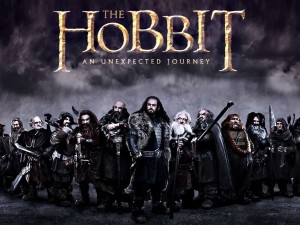THE HOBBIT: AN UNEXPECTED JOURNEY: 3 ½ PRECIOUS STARS
 At three hours the furry-footed first installment of Peter Jackson’s upcoming Hobbit trilogy is either a.) a treat for J. R. R. Tolkienites eager to explore new Middle Earth territory or b.) a butt-numbing experience ripe with baffling lore about Orc-cleavers, wizards and a slimy little creature with a split personality.
At three hours the furry-footed first installment of Peter Jackson’s upcoming Hobbit trilogy is either a.) a treat for J. R. R. Tolkienites eager to explore new Middle Earth territory or b.) a butt-numbing experience ripe with baffling lore about Orc-cleavers, wizards and a slimy little creature with a split personality.
The prequel to the immensely popular “Lord of the Rings” films is a coming of age story for Bilbo Baggins (Martin Freeman), a stay-at-home hobbit from Bag End, in Hobbiton in the Shire. He’s content with his quiet life until Gandalf (Ian McKellen), a wizard, recruits him to help a group of thirteen Dwarves (led by their king Thorin Oakenshield, played by Richard Armitage) in their quest to reclaim their former home, the Lonely Mountain, and its treasure from the dragon Smaug. It’s on this peril filled journey that Baggins matures, battles trolls, goblins and meets the creature that will shape his fate—Gollum (once again played by Andy Serkis).
As much as the story and performances, people will be talking about the presentation of “The Hobbit: An Unexpected Journey.” Shot and projected at 48 frames a second—twice the industry standard—the picture is so vivid, so pristine, it doesn’t really look like a movie. Combine that with the 3D and it’s like watching mega high-definition. Every goblin wart and troll blemish distinct enough to give dermatologists everywhere nightmares.
It’s cutting edge stuff, as much an advancement as colour in the age of black-and-white. Perhaps it’s like the difference between vinyl or CD. I prefer the warm sound of old school vinyl to the hard digital preproduction of CD. The pops and skips are part of the experience, just as film blur and grain are a part of watching 35 mm projected on the big screen.
Maybe I’m old fashioned, but I’m not sure the material is best served by the technique. Trolls, goblins Orcs and the like are the stuff of fantasy and maybe aren’t meant to be hyper-real.
Having said that Gollum is awesome at 48 frames a second. The extended scene, (for the record, most of the scenes in the film could be called extended), in which Bilbo and Gollum meet and trade riddles is one of the highlights of the film thanks to Serkis’s astounding motion capture performance. Gollum is two, two characters in one. He’s Gollum the ancient ring bearer, a nasty character corrupted by greed whose personality dominates his other persona, the sweet natured Sméagol.
Serkis switches back and forth between the two, subtly signaling the change with his posture and eye movements in what is surely one of the most fully realized performances in the film, despite the fact that most of what we see on screen is computer generated.
At one point Gandalf says about the dwarf-kind, “They’re quite a merry gathering once you get used to them,” and the same can be said about the film. Once your eyes adjust to the high-octane visuals you’ll see an epic special effects driven movie that doesn’t feel like a special effects driven movie.
Sure, this must have cost a fortune and there isn’t likely a shot that hasn’t been run through a computer to be found but director Peter Jackson wisely keeps the attention on the characters, building the story around their journey and the basic concepts that make them interesting—the primal need to belong somewhere, to be accepted, the use of power and the battle against evil.
It’s simple stuff in a movie filled with details but for the uninitiated all this talk of fairy forest realms and precious rings may make your head spin. But fans of the series will revel at the chance of revisiting the characters—even Bilbo (as played by Ian Holm) and Elijah Wood’s Frodo make an appearance in an extended (is there any other kind of scene in this movie?) prologue. “The Hobbit: An Unexpected Journey” is lighter in tone that its predecessors, but is a good companion piece to the Jackson’s other films.
